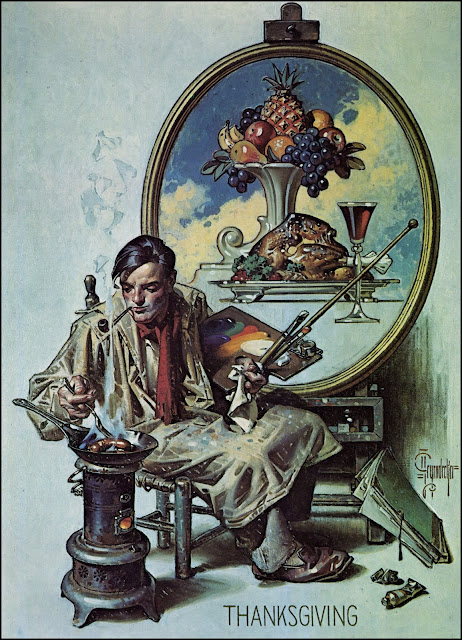One of the bedrock principles in education is repetition. Going over a fact multiple times helps fix it in our minds. The same is true of physical activity--so-called muscle memory improves as we repeat it over and over, until we no longer think about it but simply move. Golfers work hard on their stroke, basketballers on their shot, and baseballers on their swing. Artists do the same thing. Painters sketch, make studies, and paint every day. Pianists practice virtually every day, or play for others. And so on.
 |
| Duane Keiser, "Japanese Maple," oil on paper, 6x7 |
An interesting development has been the daily art movement, pioneered by
Duane Keiser, whose blog initially featured a small oil done every single day, for sale. Many others have done the same thing over the ensuring fifteen years, whether posting watercolor sketching or oils or digital drawing. Some artists offer works for sale, some post for other reasons. Regardless, daily posting requires a regular, repetitive work schedule. A British artist,
Peter Brown, aka Pete the Street, is known not only for painting every day, but doing it outdoors on big canvases in all weathers including rain and sleet. (Talk about commitment!)
 |
| Peter Brown, "Snow on Hammersmith Bridge," oil on canvas, 25x20 |
My own practice recently has included a daily posting of digital work, a commitment that forces daily work. For me the repetitive act of drawing or painting is rather like that of the athlete or musician--it is practice rather than completed work. The work becomes less formal, more fluid, in my experience.
 |
| Hoff, "Studio Tabletop," oil on paper, mounted, 6x8 |
Over the years what has varied for me is the medium used. Nearly a decade ago my daily practice was like Mr. Keiser's--a small oil every day. Most were on small gessoed panels ranging from smaller than a postcard to perhaps 6 by 8. When doing a small work every day, it was important to simply allow something to catch my eye. It could have been a bottle or spoon or even an eraser and a pair of scissors. Sometimes the way light refracted through glass was enough to trigger a painting. As a bonus, many of these paintings, which I've termed my "Windowsill Works," allowed me to study composition, light, paint properties, techniques, and any number of other aspects of oil painting.
 |
| Hoff, "Pellegrino bottle," oil on panel, 4x8 |
The problem of course is that a period of intense work with almost anything becomes routine and less inspiring than in the beginning. And given the many different ways to make art and my own lack of experience with them, it's important to keep investigating and experimenting and learning.
 |
| Hoff, "East Lake Bar & Grill," watercolor and ink, 3x5 |
A few years ago my interest shifted to watercolors (although I continue primarily as an oil painter) and I began to explore the medium via daily small works done in the studio or outdoors on site. These little watercolors are simple enough to do, require little in the way of materials, and provide excellent practice in doing some of the same kinds of things I was doing with oils, namely studying the paint as well as the methods.
Simplicity, portability, and easy cleanup made it more likely that I would not only have materials at hand, it made it more likely I'd actually make a picture. In those years I did many watercolors on postcards, on single small sheets of paper, and in sketchbooks. The continual practice flow with watercolors includes seeing, composing, drawing, painting, inking, and reinforcing. The repetition becomes inevitable habit.
In the past few years, digital art has piqued my curiosity. A digital drawing tablet (Wacom Cintiq) and increasing access to more and more sophisticated programs has made digital art considerably easier to explore. As I worked though the early stages of learning computer art programs, the tablet made it seem more like traditional media, which was enormously helpful. Gradually I began to make full drawings digitally, sometimes even a complete "painting". The thing about doing digital art work is that it's not so different from traditional media once the tool (the computer) is familiar enough to no longer be in the way of one's thoughts. That is, practice
 |
| Hoff, "Head of a Woman," digital |
with the computer eventually meant that I could concentrate on the image and not the machine. After a while, too, incorporating traditional drawing tactics like chiaroscuro into making digital drawings made my traditional work better, too. Practice.
With digital art, there is ease of correction, frequent file saving to avoid ruining a work, and opportunities to more easily practice composition and graphic design, among other advantages. You can easily manipulate the image and drawing. Of course, my Wacom tablet is hardly portable and remains a studio tool. Nonetheless, a daily digital image has become a part of my practice. Eventually I decided to share those digital works online in a blog,
Daily Digitalia, a compilation of my daily digital works. A digitalium, by the way, is a digital work of any kind.
So it's the habit of doing that is important in my studio. Repetition works.
---
Related posts
Finding a Subject
Habit and Creativity
Pete the Street




















































